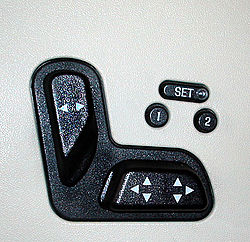
The Continental Mark III is a personal luxury car that was marketed by Lincoln from the 1969 through 1971 model years. The namesake successor of the 1956–1957 Continental Mark II, the Mark III again served as the flagship vehicle of Ford Motor Company. Produced as a two-door hardtop coupe, the Mark III was developed as a direct competitor to the Cadillac Eldorado, creating a three-decade market rivalry between the Continental Mark series and the Eldorado.

Personal luxury car is a North American car classification describing somewhat sporty, sophisticated mass-market coupés that emphasized comfort over performance. The North American manufacturers most often combined engineering, design, and marketing to develop upscale, distinctive "platform sharing" models that became highly profitable.

The Cadillac Eldorado is a luxury car manufactured and marketed by Cadillac from 1952 until 2002 over twelve generations.

The Lincoln Town Car is a model line of full-size luxury sedans that was marketed by the Lincoln division of the American automaker Ford Motor Company. Deriving its name from a limousine body style, Lincoln marketed the Town Car from 1981 to 2011, with the nameplate previously serving as the flagship trim of the Lincoln Continental. Produced across three generations for 30 model years, the Town Car served as the flagship sedan of Ford Motor Company, marketed directly against the Cadillac Fleetwood Brougham and the Chrysler Fifth Avenue.

The Oldsmobile Toronado is a personal luxury car manufactured and marketed by the Oldsmobile division of General Motors from 1966 to 1992 over four generations. The Toronado was noted for its transaxle version of GM's Turbo-Hydramatic transmission, making it the first U.S.-produced front-wheel drive automobile since the demise of the Cord 810/812 in 1937.

The Cadillac Allanté is a two-door, two-seater luxury roadster marketed by Cadillac from 1987 until 1993. It used a Cadillac chassis and running gear with a body built in Italy by coachbuilder Pininfarina. It was expensive to produce with the complete bodies flown to Detroit for final assembly. Over 21,000 were built during its seven-year production run.
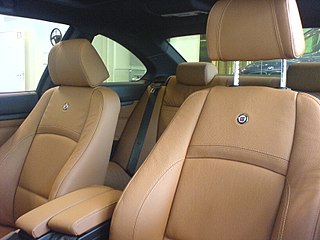
A car seat is the seat used in automobiles. Most car seats are made from inexpensive but durable material in order to withstand prolonged use. The most common material is polyester.

A steering wheel is a type of steering control in vehicles.
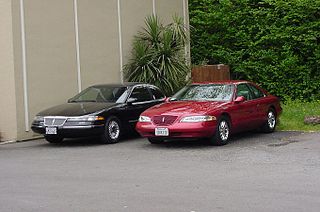
The LincolnMark VIII is a grand touring luxury coupe marketed by Lincoln from the 1993 to 1998 model years over a single generation, manufactured at Ford's Wixom Assembly Plant. Succeeding the Lincoln Mark VII, the Mark VIII shared underpinnings with the Ford Thunderbird and Mercury Cougar.
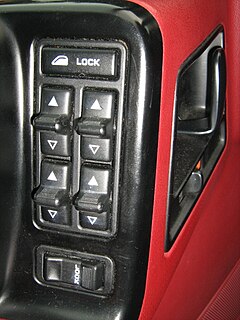
Power windows or electric windows are automobile windows which can be raised and lowered by pressing a button or switch, as opposed to using a crank handle.
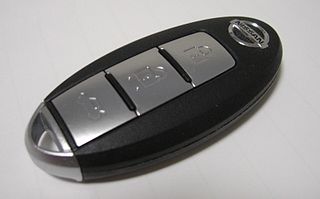
A smart key is an electronic access and authorization system that is available either as standard equipment, or as an option in several car designs. It was first developed by Siemens in 1995 and introduced by Mercedes-Benz under the name "Keyless-Go" in 1998 on the W220 S-Class, after the design patent was filed by Daimler-Benz on May 17, 1997.

Power door locks allow the driver or front passenger to simultaneously lock or unlock all the doors of an automobile or truck, by pressing a button or flipping a switch.
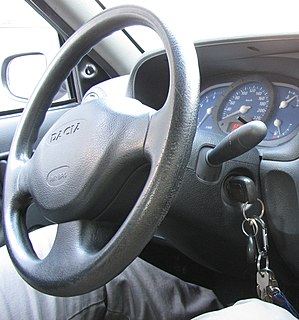
A car key or an automobile key is a key used to open and/or start an automobile. Modern key designs are usually symmetrical, and some use grooves on both sides, rather than a cut edge, to actuate the lock. It has multiple uses for the automobile with which it was sold. A car key can open the doors, as well as start the ignition, open the glove compartment and also open the trunk (boot) of the car. Some cars come with an additional key known as a valet key that starts the ignition and opens the driver's side door, but prevents the valet from gaining access to valuables that are located in the trunk or the glove box. Some valet keys, particularly those to high-performance vehicles, go so far as to restrict the engine's power output to prevent joyriding. Recently, features such as coded immobilizers have been implemented in newer vehicles. More sophisticated systems make ignition dependent on electronic devices, rather than the mechanical keyswitch. A number of these systems, such as KeeLoq and Megamos Crypto have been demonstrated to be weak and vulnerable to cryptanalytic attacks.

A remote keyless system (RKS), also called keyless entry or remote central locking, is an electronic lock that controls access to a building or vehicle by using an electronic remote control.

The Lincoln MKS is a full-sized luxury sedan that was manufactured and marketed by the Lincoln subdivision of Ford from 2008 to 2016. First shown at the LA Auto Show in November 2007, the MKS began production for the 2009 model year at Ford's Chicago Assembly plant in May 2008 with sales beginning a month later. The MKS was the second Lincoln to adopt the "MK" nomenclature and the first model to wear it through its entire production run. With the discontinuation of the Lincoln Town Car in 2011, the MKS at 205.6-inches in length became the longest production sedan sold by an American automaker through 2016.

The GV1400 Cavalcade was a Suzuki luxury touring motorcycle available from 1985 to 1988 in North America. It was available in Europe until 1991. There were three model lines, the GT, LX, and LXE. Each successive model gaining more standard features. Suzuki was the last of the major motorcycle manufacturers to introduce a luxury tourer. The Cavalcade was the largest, heaviest, and most powerful luxury tourer in 1985.

The first generation of the Ford Thunderbird is a two-seat convertible produced by Ford for the 1955 to 1957 model year, the first 2-seat Ford since 1938. It was developed in response to the 1953 Motorama display at the New York Auto Show, which showed the Chevrolet Corvette. The Corvette in turn was developed in response to the popularity of European sports cars among Americans.
A power antenna is an electrically motorized automotive radio antenna that raises and lowers either manually with a dash-mounted switch or automatically by turning the radio on or off. The automatic kind will also lower when the ignition switch is turned off. Unlike most car antennas adjusted directly by hand, power antennas retract completely beneath the surface that they are mounted on. This convenience could be found on most luxury cars by the late-1950s. The automatic power antenna became much more common in the 1970s.

The Opel Cascada is a front-engine, front-wheel drive, two-door, four-passenger subcompact fabric-roof convertible, manufactured and marketed by Opel across a single generation for model years 2013-2019, prioritizing year-round touring comfort over sportiness.

Car controls are the components in automobiles and other powered road vehicles, such as trucks and buses, used for driving and parking.
